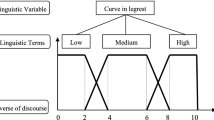Abstract
Quality function deployment (QFD) method allows reviewing of customer requirements (CRs) and design requirements (DRs) simultaneously in order to handle the correlations and relationships of CRs and DRs in calculations. It has been often combined with fuzzy numbers because it provides to gather the judgments of experts in vagueness environment more correctly and easily. This paper suggests employing q-rung orthopair fuzzy number (q-ROFN) for improving the fuzzy QFD approach. The proposed q-ROFN based QFD method uses q-ROFN to adjust the weights of CRs based the relationships between CRs and DRs with the help of the correlations and relationships of CRs and DRs. q-ROFN presents more information than numbers such as intuitionistic fuzzy number and Pythagorean fuzzy number about the correlations and relationships of CRs and DRs. VIKOR (VIsekriterijumska optimizacija i KOm-promisno Resenje) approach based on q-ROFN is also used to rank DRs. The new proposed integrated method has been applied for evaluating the anthropometry based glove design. The results show that the most important DR for anthropometry based glove design is ease of hand motion perception.



Similar content being viewed by others
References
Karwowski W (2000) Symvatology: the science of an artifact-human compalibility, theoretical issues in ergonomic science, Cilt 1, Sayı 1, Sayfa 76.
Maud PJ, Foster C (1995) Physiological assessment of human fitness. Copyright Human Kinetics, USA
Akao Y (1990) Quality function deployment: integrating customer requirements into product design. Taylor & Francis, Oxfordshire.
Onar SÇ, Büyüközkan G, Öztayşi B, Kahraman C (2016) A new hesitant fuzzy QFD approach: an application to computer workstation selection. Appl Soft Comput J 46:1–16
Lima-Junior FR, Carpinetti LCR (2016) A multicriteria approach based on fuzzy QFD for choosing criteria for supplier selection. Comput Ind Eng 101:269–285
Akbaş H, Bilgen B (2017) An integrated fuzzy QFD and TOPSIS methodology for choosing the ideal gas fuel at WWTPs. Energy 125:484–497.
Wu SM, Liu HC, Wang LE (2017) Hesitant fuzzy integrated MCDM approach for quality function deployment: a case study in electric vehicle. Int J Prod Res 55(15):4436–4449
Efe B, Efe ÖF, Kurt M (2018) Ergonomik ürün tasarımına bütünleşik bir yaklaşım. SAÜ Fen Bilimleri Enstitüsü Dergisi 22(2):192–202
Yu L, Wang L, Bao Y (2018) Technical attributes ratings in fuzzy QFD by integrating interval-valued intuitionistic fuzzy sets and Choquet integral. Soft Comput 22(6):2015–2024
Liu HC, Shi H, Li Z, Duan CY (2022) An integrated behavior decision-making approach for large group quality function deployment. Inf Sci 582:334–348
Efe B (2019a) Fuzzy cognitive map based quality function deployment approach for dishwasher machine selection. Appl Soft Comput 83:105660.
Efe B (2019b) Analysis of operational safety risks in shipbuilding using failure mode and effect analysis approach. Ocean Eng 187:106214.
Haktanır E, Kahraman C (2019) A novel interval-valued Pythagorean fuzzy QFD method and its application to solar photovoltaic technology development. Comput Ind Eng 132:361–372
Efe B, Yerlikaya MA, Efe ÖF (2020) Mobile phone selection based on a novel quality function deployment approach. Soft Comput 24(20):15447–15461
Gündoğdu FK, Kahraman C (2020) A novel spherical fuzzy QFD method and its application to the linear delta robot technology development. Eng Appl Artif Intell 87:103348.
Atanassov KT (1986) Intuitionistic fuzzy sets. Fuzzy Sets Syst 20:87–96.
Yager RR (2014) Pythagorean membership grades in multicriteria decision making. IEEE Trans Fuzzy Syst 22(4):958–965.
Yager RR (2017) Generalized orthopair fuzzy sets. IEEE Trans Fuzzy Syst 25(5):1222–1230.
Gao H, Ran L, Wei G, Wei C, Wu J (2020) VIKOR method for MAGDM based on q-rung interval-valued orthopair fuzzy information and its application to supplier selection of medical consumption products. Int J Environ Res Public Health 17(2):525
Garg H, Gwak J, Mahmood T, Ali Z (2020) Power aggregation operators and VIKOR methods for complex q-Rung Orthopair fuzzy sets and their applications. Mathematics 8(4):538
Liu P, Wang P (2018) Some q-rung orthopair fuzzy aggregation operators and their applications to multiple-attribute decision making. Int J Intell Syst 33(2):259–280
Opricovic S (1998) Multi-criteria optimization of civil engineering systems. Belgrade: Faculty of Civil Engineering.
Du WS (2018) Minkowski-type distance measures for generalized orthopair fuzzy sets. Int J Intell Syst 33(4):802–817
Chen LH, Chen CN (2014) Normalisation models for prioritising design requirements for quality function deployment processes. Int J Prod Res 52(2):299–313
Chou JR (2021) A TRIZ-based product-service design approach for developing innovative products. Comput Indus Eng 161:107608
Shi Y, Peng Q (2021) Enhanced customer requirement classification for product design using big data and improved Kano model. Adv Eng Inform 49:101340
Efe B, Efe ÖF (2021) Quality function deployment based failure mode and effect analysis approach for risk evaluation. Neural Comput Appl 33:10159–10174
Acknowledgements
The authors would like to thank to the editor and the anonymous reviewers whose insightful and constructive comments have improved the paper greatly.
Author information
Authors and Affiliations
Corresponding author
Ethics declarations
Conflict of interest
The authors do not have any conflicts.
Additional information
Publisher's Note
Springer Nature remains neutral with regard to jurisdictional claims in published maps and institutional affiliations.
Rights and permissions
About this article
Cite this article
Efe, Ö.F., Efe, B. A decision support model based on q-rung orthopair fuzzy number for glove design application. Neural Comput & Applic 34, 12695–12708 (2022). https://doi.org/10.1007/s00521-022-07118-3
Received:
Accepted:
Published:
Issue Date:
DOI: https://doi.org/10.1007/s00521-022-07118-3




